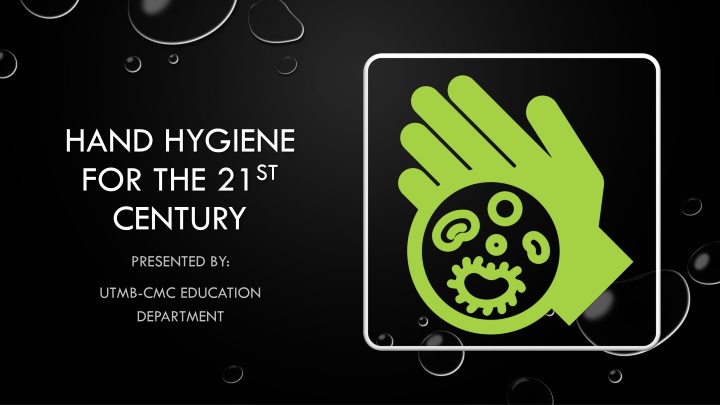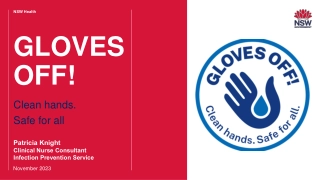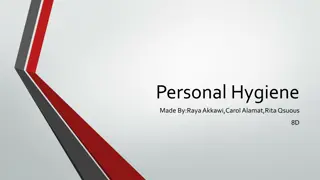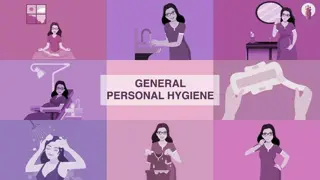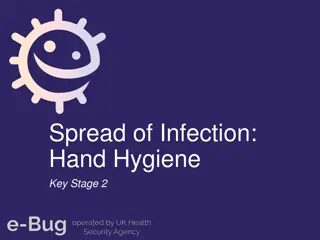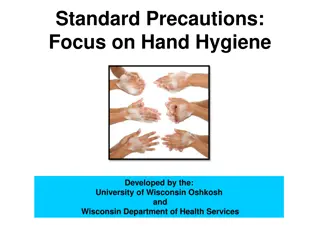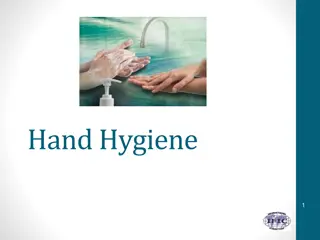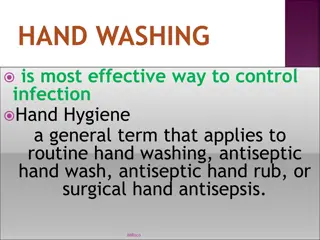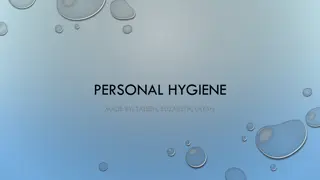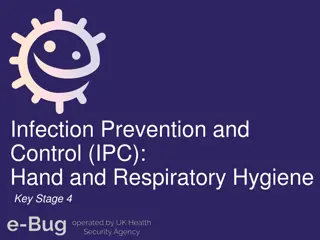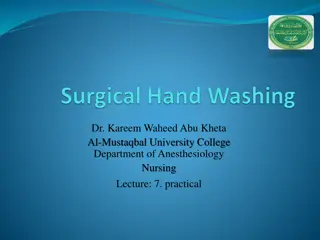Hand Hygiene for the 21st Century: A Historical Perspective
Evolution of hand hygiene practices through history, from Ignaz Semmelweis to Florence Nightingale, and learn about the impact of proper handwashing on healthcare outcomes. Discover the origins of modern asepsis and the importance of hand hygiene guidelines for infection prevention.
Download Presentation

Please find below an Image/Link to download the presentation.
The content on the website is provided AS IS for your information and personal use only. It may not be sold, licensed, or shared on other websites without obtaining consent from the author.If you encounter any issues during the download, it is possible that the publisher has removed the file from their server.
You are allowed to download the files provided on this website for personal or commercial use, subject to the condition that they are used lawfully. All files are the property of their respective owners.
The content on the website is provided AS IS for your information and personal use only. It may not be sold, licensed, or shared on other websites without obtaining consent from the author.
E N D
Presentation Transcript
HAND HYGIENE FOR THE 21ST CENTURY PRESENTED BY: UTMB-CMC EDUCATION DEPARTMENT
The History of modern-day asepsis Describe the basic principles of hand hygiene OBJECTIVES Proper Hand sanitizer and handwashing guidelines Describe when and where to wear gloves, and removal and disposal of contaminated gloves
Handwashing has been a central component of personal hygiene and a religious and cultural custom for many years. However, the link between handwashing and health was first made less than two centuries ago.
Ignaz Semmelweis, a Hungarian doctor working in Vienna General Hospital, is known as the father of hand hygiene. In 1846, he noticed that the women giving birth in the medical student/doctor-run maternity ward in his hospital were much more likely to develop a fever and die compared to the women giving birth in the adjacent midwife-run maternity ward. He decided to investigate, seeking differences between the two wards. He noticed that doctors and medical students often visited the maternity ward directly after performing an autopsy. Based on this observation, he developed a theory that those performing autopsies got cadaverous particles on their hands, which they then carried from the autopsy room into the maternity ward. Midwives did not conduct surgery or autopsies, so they were not exposed to these particles. (About handwashing History, 2017)
As a result, Semmelweis imposed a new rule mandating handwashing with chlorine for doctors. The rates of death in his maternity ward fell dramatically. This was the first proof that cleansing hands could prevent infection. (About handwashing History, 2017)
A few years later in Scutari, Italy, the Crimean War brought about a new handwashing champion, Florence Nightingale. At a time when most people believed that infections were caused by foul odors called miasmas, Florence Nightingale implemented handwashing and other hygiene practices in the war hospital in which she worked. While the target of these practices was to fight the miasmas, Nightingale s handwashing practices achieved a reduction in infections. (About handwashing History, 2017)
In recent years, handwashing with soap and other forms of hand hygiene have been gaining recognition as a cost-effective, essential tool for achieving good health and nutrition. Now that its effectiveness is no longer in question, the focus is on how to make handwashing universal. This challenge sustained handwashing practice at key times is being met with new thinking about behavior change, such as habit formation and nudges, increased research into the impact of hygiene, and collaboration in organizations such as the Global Handwashing Partnership. (About handwashing History, 2017)
Basic principles of hand hygiene
Germs are everywhere. They are within and on our bodies and on every surface you touch. But not all germs are bad. We need some of these germs to keep us healthy and our immune system strong. Your hands have good germs on them that your body needs to stay healthy. These germs live under the deeper layers of the skin. Your hands can also have bad germs on them that make you sick. These germs live on the surface and are easily killed/wiped away by the alcohol-based hand sanitizer. Alcohol- based hand sanitizers kill the good and bad germs, but the good germs quickly come back on your hands. (Hand Hygiene in Healthcare Settings, 2021)
PROPER HAND SANITIZER AND HANDWASHING GUIDELINES
BEFORE, DURING, AND AFTER PREPARING FOOD BEFORE EATING FOOD BEFORE AND AFTER CARING FOR SOMEONE WHO IS SICK WITH VOMITING OR DIARRHEA BEFORE AND AFTER TREATING A CUT OR WOUND WHEN TO USE SOAP AND WATER AFTER USING THE TOILET AFTER CHANGING DIAPERS, OR CLEANING UP A CHILD WHO HAS USED THE BATHROOM AFTER TOUCHING AN ANIMAL, ANIMAL FEED, OR ANIMAL WASTE AFTER HANDLING PET FOOD OR PET TREATS AFTER TOUCHING GARBAGE IF YOUR HANDS ARE VISIBLY DIRTY OR GREASY (WHEN AND HOW TO WASH YOUR HANDS,2020)
WHEN TO USE ALCOHOL-BASED HAND SANITIZER IF SOAP AND WATER ARE NOT READILY DO NOT USE HAND SANITIZER IF YOUR BEFORE AND AFTER VISITING A FRIEND OR AVAILABLE, USE AN ALCOHOL-BASED HAND HANDS ARE VISIBLY DIRTY OR GREASY FOR SANITIZER THAT CONTAINS AT LEAST 60% LOVED ONE IN A HOSPITAL OR NURSING ALCOHOL, AND WASH WITH SOAP AND WATER HOME, UNLESS THE PERSON IS SICK WITH EXAMPLE, AFTER GARDENING, PLAYING CLOSTRIDIOIDES DIFFICILE (IF SO, USE SOAP OUTDOORS, FISHING, OR CAMPING. IF A AS SOON AS YOU CAN. HANDWASHING STATION IS AVAILABLE, AND WATER TO WASH HANDS). WASH YOUR HANDS WITH SOAP AND WATER INSTEAD (Widmer, A. F., Dangel, M., & RN. ,2004)
HOW SHOULD I USE? SOAP AND WATER ALCOHOL-BASED HAND SANITIZER WET YOUR HANDS WITH CLEAN RUNNING WATER (WARM OR COLD), TURN OFF THE TAP, AND APPLY SOAP. USE AN ALCOHOL-BASED HAND SANITIZER THAT CONTAINS AT LEAST 60% ALCOHOL. SUPERVISE YOUNG CHILDREN WHEN THEY USE HAND SANITIZER TO PREVENT SWALLOWING ALCOHOL, ESPECIALLY IN SCHOOLS AND CHILDCARE FACILITIES. LATHER YOUR HANDS BY RUBBING THEM TOGETHER WITH THE SOAP. LATHER THE BACKS OF YOUR HANDS, BETWEEN YOUR FINGERS, AND UNDER YOUR NAILS. SCRUB YOUR HANDS FOR AT LEAST 20 SECONDS. NEED A TIMER? HUM THE HAPPY BIRTHDAY SONG TWICE. PUT ENOUGH SANITIZER ON YOUR HANDS TO COVER ALL SURFACES. RINSE YOUR HANDS UNDER CLEAN, RUNNING WATER. RUB YOUR HANDS TOGETHER UNTIL THEY FEEL DRY (THIS SHOULD TAKE AROUND20 SECONDS). DRY YOUR HANDS USING A CLEAN TOWEL OR DO NOT RINSE OR WIPE OFF THE HAND SANITIZER BEFORE IT S DRY; IT MAY NOT WORK WELL AGAINST GERMS. AIR DRY THEM. (Widmer, A. F., Dangel, M., & RN.,2004).
DO NOT use hand sanitizer if your hands are visibly dirty or greasy. USE SOAP AND WATER
WHEN AND WHERE TO WEAR GLOVES
WEAR GLOVES, ACCORDING TO STANDARD PRECAUTIONS, WHEN IT CAN BE REASONABLY ANTICIPATED THAT CONTACT WITH BLOOD OR OTHER POTENTIALLY INFECTIOUS MATERIALS, MUCOUS MEMBRANES, NON-INTACT SKIN, POTENTIALLY CONTAMINATED SKIN OR CONTAMINATED EQUIPMENT COULD OCCUR. GLOVES ARE NOT A SUBSTITUTE FOR HAND HYGIENE. IF YOUR TASK REQUIRES GLOVES, PERFORM HAND HYGIENE PRIOR TO DONNING GLOVES, BEFORE TOUCHING THE PATIENT OR THE PATIENT ENVIRONMENT. PERFORM HAND HYGIENE IMMEDIATELY AFTER REMOVING GLOVES. CHANGE GLOVES AND PERFORM HAND HYGIENE DURING PATIENT CARE, IF GLOVES BECOME DAMAGED. GLOVES BECOME VISIBLY SOILED WITH BLOOD OR BODY FLUIDS FOLLOWING A TASK. MOVING FROM WORK ON A SOILED BODY SITE TO A CLEAN BODY SITE ON THE SAME PATIENT OR IF ANOTHER CLINICAL INDICATION FOR HAND HYGIENE OCCURS. NEVER WEAR THE SAME PAIR OF GLOVES IN THE CARE OF MORE THAN ONE PATIENT. CAREFULLY REMOVE GLOVES TO PREVENT HAND CONTAMINATION. When to wear gloves (2021)
How to Remove Gloves Grasp the outside of one glove at the wrist. Do not touch your bare skin. Peel the glove away from your body, pulling it inside out. Hold the glove you just removed in your gloved hand. Peel off the second glove by putting your fingers inside the glove at the top of your wrist. Turn the second glove inside out while pulling it away from your body, leaving the first glove inside the second. Dispose of the gloves safely. Do not reuse the gloves. Clean your hands immediately after removing gloves. When to wear gloves (2021)
CONCLUSION PERSONAL HYGIENE BEGINS AND ENDS WITH OUR HANDS. IT IS IMPORTANT TO REMEMBER THAT GERMS DON T CARE WHAT TIME OF DAY IT IS. CLEAN HANDS ALWAYS PREVENT SICKNESS. THAT S IS WHY IT IS IMPORTANT TO LEARN THE BASICS ABOUT HAND HYGIENE SO THAT YOU, TOO, CAN BECOME AND CONTINUE TO BE A CHAMPION HAND WASHER.
REFERENCES ABOUT HANDWASHING HISTORY (2017). RETRIEVED FROM HTTPS://GLOBALHANDWASHING.ORG/ABOUT-HANDWASHING/HISTORY- OF-HANDWASHING/PAGE THE GLOBAL HANDWASHING PARTNERSHIP (GHP) HAND HYGIENE IN HEALTHCARE SETTINGS (2021) RETRIEVED FROM HTTPS://WWW.CDC.GOV/HANDHYGIENE/PROVIDERS WHEN AND HOW TO WASH YOUR HANDS (2020) RETRIEVED FROM HTTPS://WWW.CDC.GOV/HANDWASHING/WHEN-HOW- HANDWASHING HANDWASHING AND HAND SANITIZER USE AT HOME, AT PLAY, AND OUT AND ABOUT, PUBLISHED (2020) RETRIEVED FROM HTTPS://WWW.CDC.GOV/HANDWASHING/PDF/HANDSANITIZER-P.PDF PGS.1-2 WIDMER, A. F., DANGEL, M., & RN. (2004). ALCOHOL-BASED HAND RUB: EVALUATION OF TECHNIQUE AND MICROBIOLOGICAL EFFICACY WITH INTERNATIONAL INFECTION CONTROL PROFESSIONALS. INFECTION CONTROL AND HOSPITAL EPIDEMIOLOGY, 25(3), 207-209 GUIDELINES FOR HAND HYGIENE IN HEALTHCARE SETTINGS PUBLISHED 2002 PDF ICON[PDF 496 KB] ; PP. 8 AND 32. WHEN TO WEAR GLOVES (2021) LAST UPDATED JULY 16, 2020 RETRIEVED FROM:HTTPS://WWW.CDC.GOV/CORONAVIRUS/2019- NCOV/PREVENT-GETTING-SICK/GLOVES.HTML CONTENT SOURCE: NATIONAL CENTER FOR IMMUNIZATION AND RESPIRATORY DISEASES (NCIRD), DIVISION OF VIRAL DISEASES
